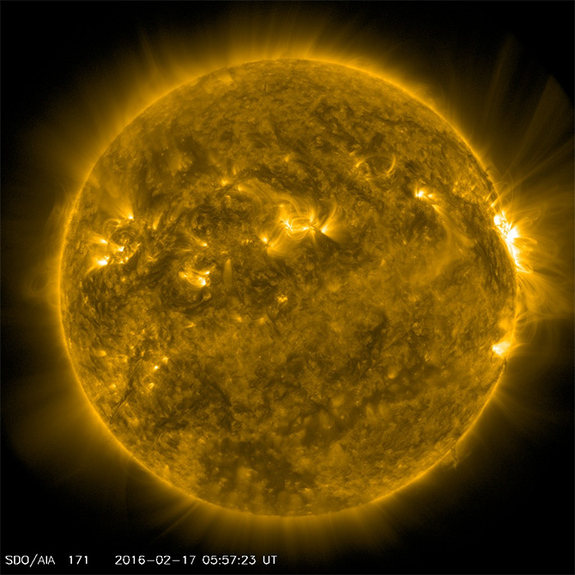
23 high-definition observations of our nearest star have been compiled into a single solar portrait.
Credit: NASA’S Goddard Space Flight Center/SDO/S. Wiessinger
In a dramatic new composite image released by NASA, 23 high-definition observations of our nearest star have been compiled creating the mother of all solar portraits.
PHOTOS: Simmering Solar Views from SDO
Observed by NASA’s Solar Dynamics Observatory (SDO) , the images were collected between Jan 11, 2015 to Jan. 21, 2016 and it is very clear where the sun is most active. The bright band through the middle of the solar disk is 12 months worth of bright active regions in the lower corona — the multi-million degree solar atmosphere.
Through the sun’s approximate 11-year solar cycle, magnetic activity from the sun’s interior becomes more fierce, reaching “solar maximum” when solar flares and coronal mass ejections are commonplace. Space weather can have serious impacts on our planet around these times. These explosive events occur over active regions — regions of intense magnetic activity that cause intense heating of solar plasma . At the base of these active regions, sunspots dominate, where the hotter surface layers of the chromosphere are pushed aside, exposing the cooler interior. Active regions tend to erupt around the sun’s equator, a pattern that is highlighted here.
PHOTOS: Weird and Wonderful SOHO Observations
After the crescendo of solar maximum peaks, the sun’s global magnetic field begins to ebb, eventually reaching “solar minimum”, when the sun settles into a quiescent state. We are currently experiencing the downward slope to quiescence since the sun hit solar maximum around 2012-2013. But as you can see from this beautiful portrait, the sun certainly isn’t going quietly.
The Solar Dynamics Observatory has just started its sixth year of operations (it was launched on Feb. 11, 2010), continually staring at the sun, revealing never-before seen dynamics in the sun’s outermost layers and its extended corona. This particular series of observations were recorded using the AIA instrument’s 171 angstrom filter. The emissions from the corona at these wavelengths are produced by plasma heated to over 1 million degrees Kelvin (Celsius). Active regions are a hotbed of coronal heating and therefore appear bright to the 171A filter.
As a comparison to the composite image, here’s a raw single observation from SDO as captured earlier today:

Source: NASA Goddard Space Flight Center Flickr
This article was provided by Discovery News .

Comments are closed.